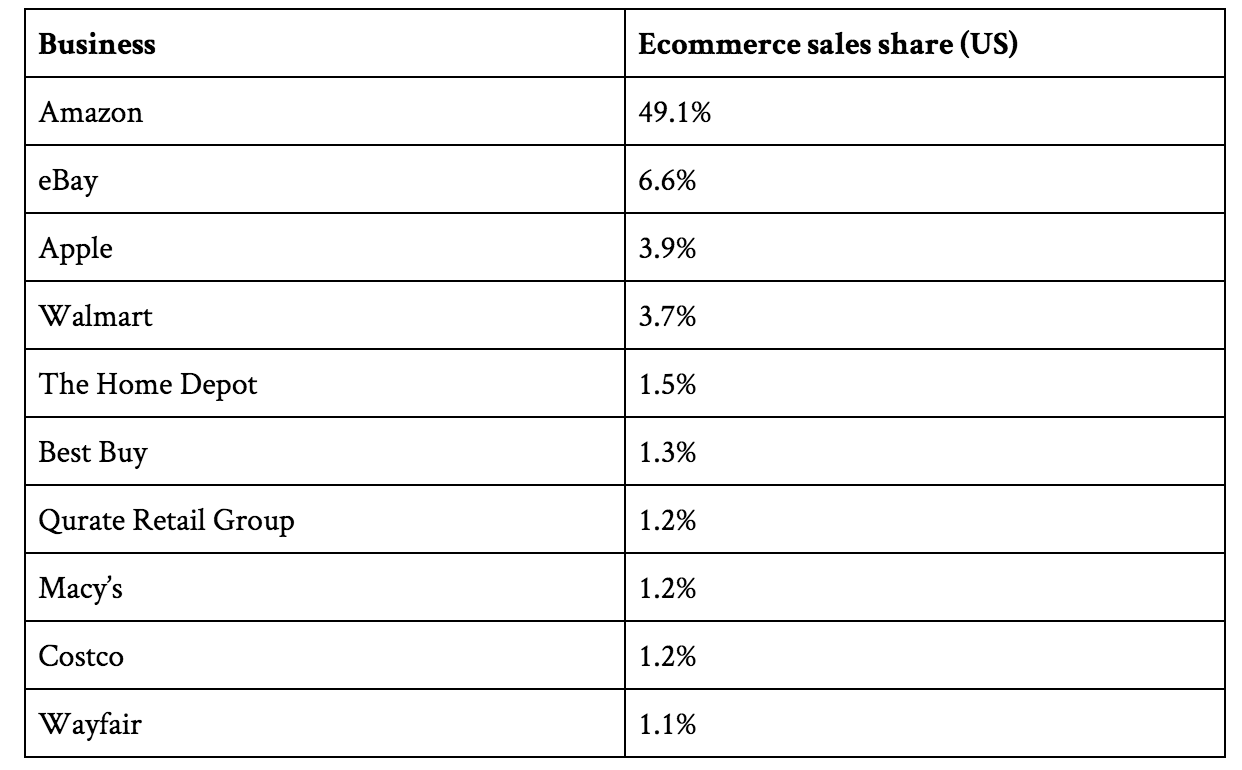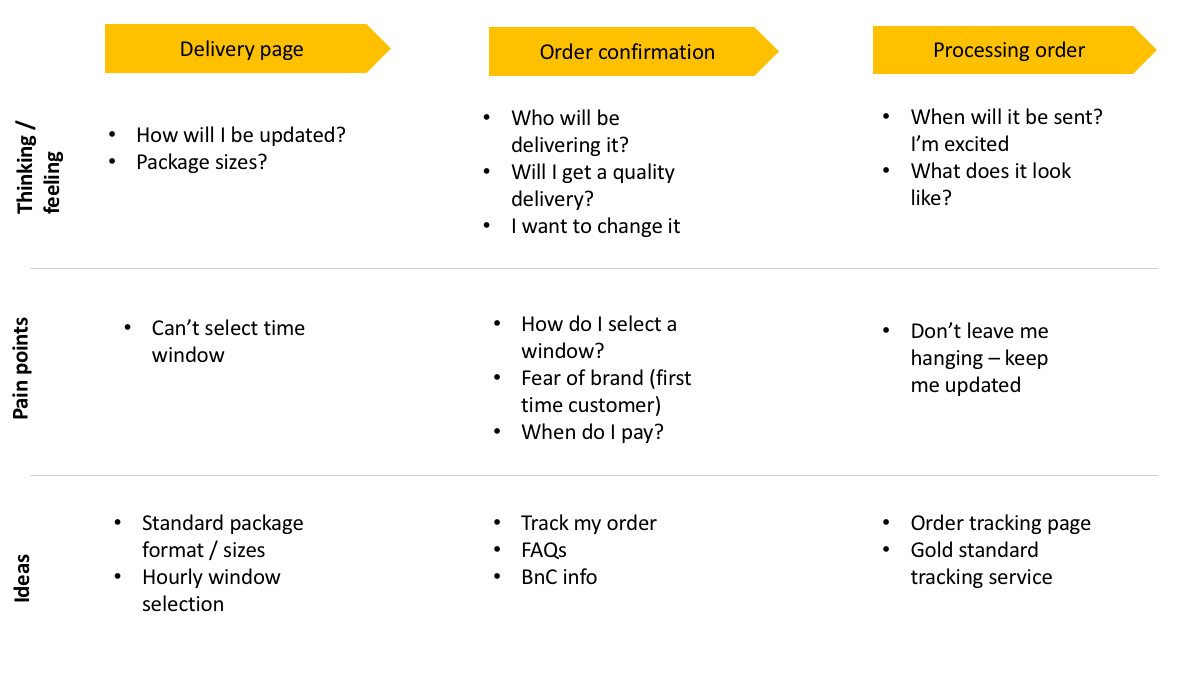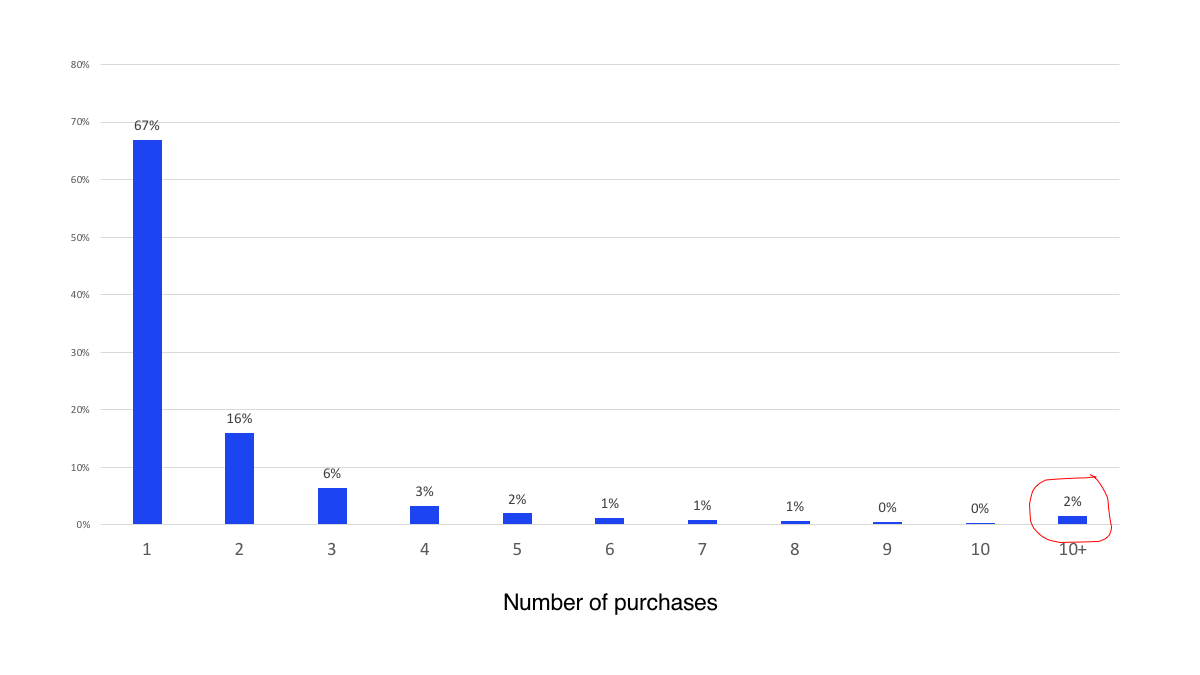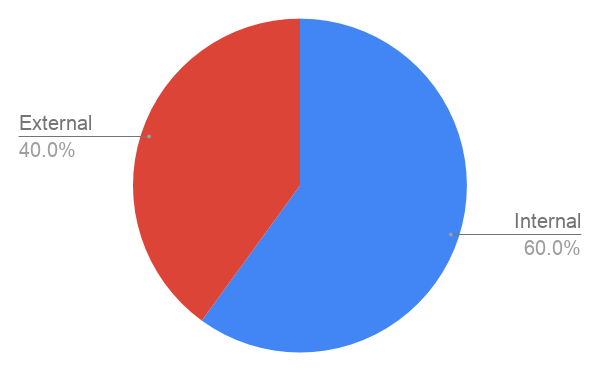Crafting Ecommerce Product Strategies
How the customer lifecycle can help structure your product strategy
The business of ecommerce
With Amazon gobbling up almost 50% of ecommerce sales in the US, traditional high street retail in steady decline and paid online customer acquisition costs driven up by increased competition, ecommerce continues to be a volatile space for incumbents and new entrants alike.

Faced with the increasingly monopolistic threat of the major players, smaller ecommerce businesses in particular are being forced to reassess their strategic profile and make some tough decisions to remain compelling.
Success in the ecommerce space largely boils down to what it is you’re selling and who you’re selling it to. No matter how optimized your agile product development processes or how motivated your team, if you’re trying to sell things that people don’t want to people who don’t want them, you’re in for a bumpy ride. Product SKU curation and creation is as critical as digital product development.
Gwyneth Paltrow’s Goop.com is estimated to be worth $250 million, proving that there is a sizeable market for Mermaid Shampoo, Emotional Detox bath soaks and Spirit Dust after all.
The rise of the so-called vertically integrated model where businesses focus on a small number of niche products sold and shipped globally is in many ways a reaction to the dominance of the so-called ‘everything stores’ of Amazon, Walmart and co. Upmarket suitcase brand Away and eyewear brand Warby Parker are fine examples of what can be achieved by ignoring the vast majority of things which could be sold online and instead focusing on delivering one product category to a well-defined audience.
That said, assuming you’re selling things people actually want to buy, the product team still plays a critical role in driving revenue in ecommerce businesses.
Ecommerce product terminology explained
If you’re new to the world of ecommerce, some of the terminology can be a little overwhelming. Here’s a selection of terms that you might hear in your first role in ecommerce:
- PDP – product description page. The page which describes the product in more detail.
- PLP – product listing page. These can be both search results pages and ‘hub’ pages which are curated by category managers.
- SRP – search results page.
- AOV – average order value. Largely determined by the price of the products you sell, but also the propensity of customers to add more than 1 item to basket.
- Category managers – members of staff in ecommerce businesses who manage specific SKU categories.
- LTV – customer lifetime value. How much revenue you can expect to generate from a single customer over their lifetime.
- ATF – average transaction frequency. How frequently a customer purchases over a given time period.
- TOF – top of the funnel.
- CPA – cost per acquisition. How much it costs you to acquire 1 customer.
- SKU – stock keeping unit, used to describe an individual unit of product stock.
The ecommerce customer lifecycle and product strategy creation
Product teams in ecommerce companies need to be well-versed in the stages of the ecommerce customer lifecycle. Product teams (and we’re including engineering in this, too) will often be split into ‘Find it’ and ‘Buy it’ workstreams, which naturally lend themselves to the typical ecommerce customer lifecycle.
However, the key components of the ecommerce customer lifecycle can and should also play an integral part in your product strategy creation and roadmap building.
How?
The ecommerce customer lifecycle comprises 4 key parts:
- Acquisition
- Conversion
- Post purchase
- Repurchase
This lifecycle can be a useful framework to structure your thinking.
OKRs can be derived from this customer lifecycle. Roadmap items can be prioritised based on their alignment to individual lifecycle metrics and stakeholder discussions can be carefully structured using the ecommerce customer lifecycle as a framework for making decisions on strategic priorities and trade offs.
If you find yourself in a debate with a stakeholder about a must have feature, plot the request against the 4 parts of the lifecycle to understand where it fits in the customer journey and whether this part of the lifecycle is a priority for your business right now.
Creating your ecommerce product strategy using the customer lifecycle
Start with some simple diagnostic assessments and goal setting and ask yourself some fundamental questions:
- Where are you today?
- Where do you want to be?
- Which part of your ecommerce customer lifecycle are you going to focus on improving? Why?
- What does success look like and how can this be quantified?
Be specific in your goals / OKRs for the relevant teams as you create your product strategy. You might decide, for example, that an ambitious goal for next year is to increase your repurchase rate from 10% to 25%. You might decide that increasing your average order value to $200 is an achievable, sensible target. Contextualise your strategic goals by mapping them directly back to the relevant stage of the customer lifecycle.
This doesn’t mean that you shouldn’t do anything that doesn’t naturally map back to the customer lifecycle; you can – and should – prioritise work which doesn’t, but mapping back to the customer journeys means you’re mindful of those types of decisions.
1. Acquisition
Customer acquisition through paid marketing is usually the concern of your marketing teams, but alignment with marketing to ensure you understand who exactly you’re targeting is critical. All too often, there is a disconnect in ecommerce businesses between who the marketing team is targeting in campaigns and who the product team think they are building solutions for.
Aim to understand the core audience types your marketing team are targeting across campaigns and to understand which audience segments convert best and why. Factor these audiences into your decision making and design conversations across the product team.
Work closely with your marketing teams to explore potential new audiences, too. Usability testing sessions and UX research can be shared with marketing folks to ensure you’re continuously learning about and evolving your target user base.
- How can you help reduce the cost per acquisition?
- How can you improve conversion rates on landing pages?
- In what ways can the product team help with SEO and customer acquisition more broadly?
If your business is struggling to attract the traffic you need, work with your marketing teams to focus your product efforts on the acquisition part of the customer lifecycle.
2. Conversion
This is perhaps the crux of where product managers and product teams in general can have the most impact. With your marketing teams having driven relevant traffic to your site, it’s the product team’s role to convert these into customers – ideally customers who will purchase multiple times.
‘Find It’ conversion
The purpose of the ‘Find It’ team is to ensure that customers can find items as quickly and efficiently as possible and you’ll want to consider a few things:
- Relevancy – how relevant are product search results? Do your product description pages (PDPs) accurately reflect the product? Are you surfacing useful product reviews? Perhaps there’s scope to A/B search results based on the profile of the user or the search terms used?
- Usability – can customers get to the relevant product pages without the burden unnecessary friction?
- Speed – does your site load quickly enough? Get hold of page load speed times for across your site and relentlessly pursue speed improvements across the core parts of your site.
- Inspiration – Customers also like to be surprised and inspired and they don’t always know what they want. Work closely with the creative teams in your business and your data scientists to accurately predict what users might want and to give them a reason to come back again.
Metrics for measuring Find It conversion include add to bag rates, average order value and PDP dwell time. Don’t fall into the trap of trying to prioritise every single metric; pick and prioritise which ones matter most to the goals you’re setting and use these to determine your strategic direction.
‘Buy It’ conversion
Some product roles are focused exclusively on conversion rate optimisation, with much of this focused on checkout. This is the responsibility of the Buy It team.
As the name suggests, the Buy It team is responsible for delivering a seamless, joyful buying experience. A feat which is often easier said than done, particularly in larger matrix organisations with competing commercial interests and concerns. What does that mean?
The Head of Partnerships wants to slap a third party credit card application button on the first page of checkout and your Marketing Director wants to force users to sign up for an account with all the trimmings. Creating a checkout experience with the user at the centre of decision making is more difficult than you’d imagine. Your role is to balance the commercial interests of the business with the personal interests of the user.
The importance of optimising your checkout flow shouldn’t be underestimated, though. A small % uplift in checkout conversion can have a significant impact on a business’ overall bottom line. If your Head of Partnerships is arguing that the credit card application button is likely to bring an additional $1m a year, try pitting this against a % increase in checkout conversions to see how the two stack up next to each other.
Checkout conversion rate optimisation work is sometimes de-prioritised by companies who seek ‘sexier’ alternatives by focusing on new functionality over the optimisation of existing user journeys.
Ecommerce product strategy is often determined not by what’s best for the customer but by what looks best on a PowerPoint presentation to exec-level stakeholders. To maximise your chance of convincing your stakeholders to prioritise conversion rate optimisation work, make it explicitly clear what a % uplift means in revenue terms.
Themes to consider for improving checkout conversion
If you’re working in the Buy It stream of an ecommerce product, here’s a few things you might consider focusing on for improving checkout conversion:
- Error audits – before you start digging into UX improvements, conduct a full audit of the number of card errors you’re seeing today. Try segmenting these into preventable errors vs. non-preventable errors and speak to your payment gateway to identify ways to bring these down. This one action alone can often result in significant revenue uplifts.
- Mobile – are you making the checkout as easy as possible on mobile? When designing for mobile user journeys ditch your desktop and actually review the flows on your mobile, not your laptop.
- Address management – how easy is it for customers to add, remove and edit addresses in checkout? Tools like Loqate make finding and validating addresses easier for users which have positive downstream implications for shipping later.
- Payment methods – users are increasingly demanding flexible payment options. Audit the options you have today and decide whether there’s scope for new payment options. New payment providers such as Klarna offer customers the ability to buy on credit and pay back in instalments, for example.
The benefits of a Checkout Health Scorecard
As a product team focused exclusively on the buying experience, you might want to consider creating a checkout health scorecard. The scorecard will consist of metrics which indicate the overall health of your checkout experience. The exact metrics you include will depend on your exact checkout set up, but your health scorecard can include metrics such as:
- Full checkout abandonment rate
- Successful transactions processed
- Payment transaction card failures (by type)
- Number of validation errors by form field
- Preventable card failures (by type)
- Payment processor API connectivity failures
- Number of live chats initiated
On a monthly or quarterly basis, review the overall health of your checkout and present back to the business opportunities for improvements.
3. Post purchase

What happens when a customer places a purchase? For some companies, this is where things go downhill.
Amazon is has set customer expectations for the post-purchase experience. You can no longer leave your customers in a black hole of post-purchase radio silence in the vague hope they’ll be happy with whatever lands on their doorstep. Customers expect to know when their item will be shipped, when it’s likely to arrive and to be kept in control of their order throughout the journey.
Whilst the upsides of a strong post-purchase experience might not be as obvious as, say, an improved checkout conversion %, leaving customers with a pleasant post-purchase aftertaste is a potential influencing factor in whether or not they’re likely to re-purchase in the future.
So what can be done to improve your customer’s post-purchase experience?
The first step is to map out how the post purchase experience looks today and how you might be able to improve this in the future. Identify areas of weakness and, ideally with the help a cross-functional unit, come up with some ways in which you might be able to make this uniquely delightful.
Work closely with your fulfilment partners to identify opportunities for improving your delivery options. The likes of DPD, DHL, Hermes and Yodel all offer some form of in-flight changes and tracking. What can you do not only to offer these services but also to add a layer of personalisation and branding to differentiate yourself from your competitors? Re-engaging with your overall business strategy can help you to generate ideas here.
Returns rates are naturally high in ecommerce. How can you make this as stress-free as possible for your customers? Printer-free label options are becoming increasingly more popular so whilst offering your customers easy ways to return items in the most efficient way possible might seem counter-intuitive in the short term, in the longer term customers will thank you for it.
4. Repurchase
What percentage of your customers purchase once only? If you don’t know, go and find out. The number will likely surprise you since it’s usually higher than most companies would like it to be.

In our experience, the vast majority of customers in smaller ecommerce companies will only buy once. Yes, we’re ignoring the Amazon Prime factor here, but repurchase rates in general are pretty poor.
Purchases from Amazon:
2010: 1
2011: 0
2012: 2
2013: 3
2014: 41
2015: 46
Wondering how much of this is forming a new habit, and how much is that I moved from London to SF in 2014 and Amazon became the only way to get most of those things— Benedict Evans (@BenedictEvans) August 19, 2018
Since you’ve already spent money acquiring those customers once through paid marketing, it makes a lot of sense to try to increase their repurchase rate. And increasing the repurchase rate is a sensible key result to work towards for when crafting your ecommerce product strategy.
Practical steps to improving your repurchase rate
Ultimately, every ecommerce business is different, selling different products to different customers in different territories, so you’ll need to decide on how best to tackle this for your vertical. Having said that, here’s a few opportunities you might want to consider exploring and tailoring to your ecommerce business to boost your repurchase rate:
- Subscriptions – are any of your products suitable to be turned into subscriptions? Subscriptions are inherently repurchase drivers and can be a useful stream of recurring revenue. Consider whether subscriptions could be created on a specific SKU basis and also whether it makes sense to bundle SKUs into unique subscription propositions for your brand.
- Brand following – if your ecommerce site sells predominantly third party products, consider how you might allow customers to follow their favourite brands. Loyal brand followers might be more inclined to repurchase items from their favourite brands when a new product from the brand hits your store.
- Power purchaser analysis – whilst repurchases are rare, you will discover that a small segment of your users will be ‘power-purchasers’ who buy an obscene amount from you each year. This group of customers can be a very interesting case study for your data teams to analyse carefully. Try to understand what shared characteristics this segment might have in common and what this means for your product strategy. Are there more of these power purchasers in the market – and how can you attract more of them?
Creating your ecommerce Product Roadmap
Once you’ve explored the ecommerce customer lifecycle and identified areas of strategic importance, you’ll need to make some decisions on where to allocate time and resources. Your roadmap is a device to communicate your strategic decisions and the product priorities which reflect those decisions across a rough spectrum of time.
In the context of ecommerce, you might be able to structure your roadmap a little differently to reflect the strategic decisions and goals you’ve set yourself. Check out our selection of product roadmaps to see which one might be suitable for you.
Useful third party tools for ecommerce products
Finally, a quick note on third party tools.
It’s common for ecommerce businesses to rely quite heavily on third party tools and products to enhance their offerings. Think carefully before integrating with third parties for core product functionalities. Being dependent on third party services clearly has its upsides but it’s a risky business too. Try to strike a healthy balance between what seems appropriate for your teams to build in-house vs. what third parties can offer you based on the resources, budgets and time you have available.

It’s also useful to analyse your roadmap to visualise how much of your roadmap is dedicated to ongoing internal tool management vs. external customer facing value.
Here’s a selection of some of our favourites:
- Monetate – personalisation and A/B testing tool with plenty of scope for customisation
- Loqate – formerly known as PCA, Loqate is the world’s leading address management tool designed to improve address form field usability in the checkout – and to prevent address errors from having further implications downstream.
- Fred Hopper – a search engine tool to power your ecommerce site. Search result algorithms can be created by category managers using potions.
- Bazaarvoice – reviews can have a positive impact on your PDP conversion metrics. Bazaarvoice is a review platform which pulls in syndicated reviews from third parties and hosts native reviews from within your own product, too.
- Yext – if your ecommerce business also has a physical store presence, Yext is a powerful piece of software which allows you to create one central source of truth for location data and push this to third parties.



